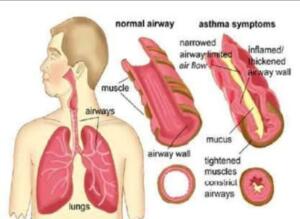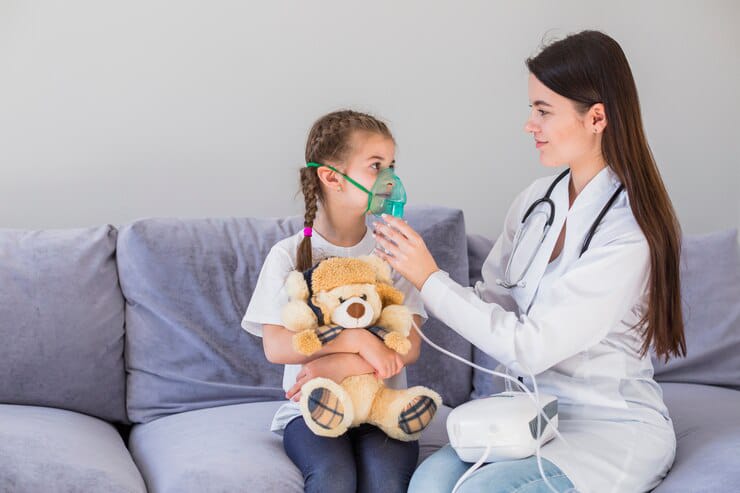10 FAQs on HOME CARE OF CHRONIC ASTHMA
1. What is asthma?
2. What are the symptoms of asthma?
3. Why did my child get asthma?
4. How will I identify if my child is having an asthma attack and how do I manage it at home?
5. How do I prevent my child getting an asthma attack?
6. is preventer inhaler (corticosteroid) habit forming for my child and what are the side effects?
7. How do I give the inhalers to my child?
8. How should I clean the inhalers and spacer?
9. Does my child require lifelong treatment?
10. Will Ayurveda, Homeopathy, Yoga, changing food habits, exercise, and fish therapy help my child?
What is asthama?

Why did my child get asthma?
Asthma is a multifactorial (many contri buting causes) condition. It can occur without any identifiable risk factor or due to long-term exposure to inhaled allergens (eg. tobacco smoke, air pollution) and can sometimes run in families. Some children with asthma may also have other symptoms of allergy like rhinitis (runny nose) and eczema.
Why did my child get asthma?
Asthma is a multifactorial (many contri buting causes) condition. It can occur without any identifiable risk factor or due to long-term exposure to inhaled allergens (eg. tobacco smoke, air pollution) and can sometimes run in families. Some children with asthma may also have other symptoms of allergy like rhinitis (runny nose) and eczema.
How will I identify if my child is having an asthma attack and how do I manage it at home?
Your child suddenly develops symptoms or their symptoms are worse tha Some symptoms to look for are:
4/8
Your child is:
Finding it hard to breathe
Breathing faster than usual
Wheezing and coughing
Complaining of a tight chest.
Unable to complete a full sentence
How will I identify if my child is having an asthma attack and how do I manage it at home?Your child suddenly develops symptoms or their symptoms are worse tha Some symptoms to look for are:
4/8
Your child is:
- Finding it hard to breathe
- Breathing faster than usual
- Wheezing and coughing
- Complaining of a tight chest.
Unable to complete a full sentence
If this happens: Start giving four puffs of salbutamol (blue) inhaler via spacer + mask and repeat similarly every 20 minutes. Please make sure your child is sitting up and keep him/her calm. If there is no improvement in symptoms after 1 hour, then your child will require emergency hospital visit.
If your child’s symptoms improve, then continue giving the four puffs of salbutamol (blue) inhaler every 4 hours, and slowly increase the interval between doses until your child’s breathing is back to normal.
Always use your child’s written asthma action plan given by the doctor as a guide.
Can I use a nebulizer at home to treat my child, if he/she has an asthma attack?
Nebulizers should not be used at home. Sometimes nebulizers cause more harm than good and make your child’s condition worse.
What are the different types of inhalers?
There are two types of inhalers:
1. Reliever inhaler (Blue): Salbutamol helps to open up your child’s breathing tubes during an asthma attack and gives relief from immediate symptoms. Therefore, it is called “a reliever
2. Preventer or controller inhalers (there are many different types and doses, and come in different colors): The active medicine in preventer inhaler is corticosteroid. They reduce the thickening and sensitivity of the breathing tubes in a child with asthma thereby controlling asthma symptoms. The benefit of these inhalers builds up over time, and hence these inhalers should be taken regularly everyday.
Your child’s doctor will choose an inhaler that best suits your child according to their age and severity of symptoms. Spacer devices make it easier to get the right amount of medicine, and it is important that all inhalers are taken through a spacer device to ensure the medicine reaches the breathing tubes.
Your child should always rinse their mouth after using a preventer inhaler

How do I prevent my child getting an asthma attack?
Make sure your child takes the prescribed preventer drugs daily even when they are well. Do this by giving it in a younger child and supervising it in the older child.
Have regular asthma check-ups with your child’s doctor every 3-6 months (more frequently, if needed).
Monitor symptoms.
Please use a personalized “asthma
action plan”
Get a flu injection every year.
Things that trigger your child’s asthma should be avoided where possible (eg, perfumes, sprays, mosquito coils/mats, agarbatti, fireworks, house dust mite, animal fur, pollen, tobacco smoke, cockroach, and cold air).
Is preventer inhaler (corticosteroid) habit forming for my child and what are the side effects?
- Taking the preventer inhalers is beneficial to your child as their asthma symptoms will be controlled and they can carry on with their normal activities without breathing difficulty.
- A single puff of the preventer inhaler contains a very small dose of steroid and is not habit forming. The tiny doses of inhaled steroids which are used in most children with asthma do not have significant side effects. The small risk of any side effects are further reduced by using the spacer device with the inhaler.
How do I give the inhalers to my child?
Please refer to the video in this link:
First shake inhaler.
Attach inhaler to spacer.
Make sure your child is sitting upright.
Under 5 years, hold spacer device with.
mask securely over mouth and nose.
Over 5 years, seal lips firmly around mouth piece of spacer device.
Press inhaler once to give one puff.
Take 5-10 breaths
Repeat steps 1-6 for further doses.
For children ≤5 years: https://www. youtube.com/watch?v=L6uJru2e-1c
For children 5 years: https://www. youtube.com/watch?v=rUfxPK-Y158
How should I clean the inhalers and spacer?
Remove the metal canister from the plastic casing of the inhaler and remove the mouthpiece cover. Rinse the plastic casing thoroughly under running water. Dry the plastic casing thoroughly inside and outside. Put the metal canister into the plastic casing, test it by releasing a single puff into the air, and replace the mouthpiece cover.
Wash the spacer device with lukewarm water every month. Allow to drip dry and do not use a cloth to wipe dry.
Does my child require lifelong treatment?
Younger children with asthma-like symptoms improve and sometimes grow out of their symptoms around. 6 years of age. They will not need further treatment.
In school-going children above the age of 6 years, asthma is usually a lifelong condition with some periods of temporary relief. Your child’s doctor will step-up or step-down the asthma treatment accordingly. Please do not stop the preventer inhalers without consulting the doctor.
Will Ayurveda, Homeopathy, Yoga, changing food habits, exercise, and fish therapy help my child?
There is no known cure for asthma. Preventer inhalers are the recommended treatment for asthma to control symptoms. If these are not taken regularly, your child can continue to have symptoms and it can put your child at risk of a life-threatening attack.
Ayurveda/Homeopathic medicine has no proven role for asthma treat-ment
Exercise is beneficial, and if preventers are taken regularly, should not trigger your child’s symptoms.
Yoga and breathing exercises are good habits, which are of overall benefit for your child.
Make sure your child eats healthy food including vegetables, fruit, and fish.
Fish therapy is very fishy indeed and not recommended.


